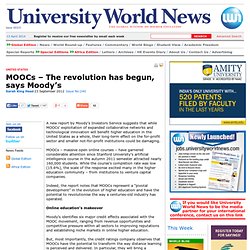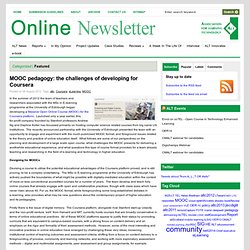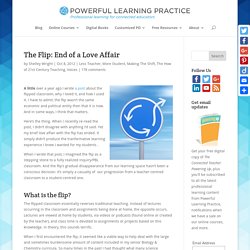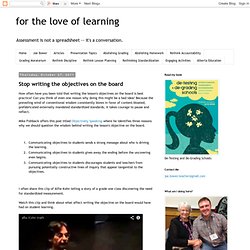

MOOCs – The revolution has begun, says Moody’s. A new report by Moody’s Investors Service suggests that while MOOCs’ exploitation of expanded collaborative networks and technological innovation will benefit higher education in the United States as a whole, their long-term effect on the for-profit sector and smaller not-for-profit institutions could be damaging.

MOOCs – massive open online courses – have garnered considerable attention since Stanford University’s artificial intelligence course in the autumn 2011 semester attracted nearly 160,000 students. To MOOC or Not to MOOC - WorldWise. MOOCs have become a media obsession.

Why? In part because they are the continuation of a story that has been around since at least the 1990s and the first days of magazines like Wired and Fast Company. At that time, information technology was depicted as part of a revolution: Marxist rhetoric had been appropriated by capitalism. Information technology would change everything through a peculiar mix of a corporate charge and evangelism, expanded profit opportunities and enlightenment.
I’d like to think that since then we’ve learned something. After all, universities have produced a substantial body of research that argues that information technology is not an epochal economy-changing technology. These sources must induce at least some suspicion about the wider claims concerning MOOCs, or massive open online courses. Why this obsession with MOOCs? What is a MOOC? Success in a MOOC. Team MOOC. MOOC Articles. MOOC MOOC.
MOOC Reviews. MOOC Articles. MOOC pedagogy: the challenges of developing for Coursera. In the summer of 2012 the team of teachers and researchers associated with the MSc in E-learning programme at the University of Edinburgh began developing a Massive Open Online Course (MOOC) for the Coursera platform.

Launched only a year earlier, this for-profit company founded by Stanford professors Andrew Ng and Daphne Koller has focussed primarily on hosting computer science related courses from big name US institutions. The recently announced partnership with the University of Edinburgh presented the team with an opportunity to engage and experiment with the much-publicised MOOC format, and foreground issues related to the theory and practice of online education itself. Designing for MOOCs Devising a course to utilise the potential educational advantages of the Coursera platform proved, and is still proving, to be a complex undertaking. MOOC Articles. MOOC design. Learning Initiative 7 Things You Should Know About MOOCs. MOOCs. The future of MOOCs. MOOCs get a bad rap.

Dismissed as prescriptive, or teacher-centric, or unsocial, or something else, it’s like a badge of honour to espouse why you dislike MOOCs. Despite their pedagogical flaws, however, MOOCs provide unprecedented access to quality content for millions of learners. It’s all very well for Apple-owning, organic-buying professionals to cast aspersions, but consider the girl in Pakistan who’s too scared to set foot in a classroom. Consider the teenager in central Australia whose school has only one teacher. Consider the young woman in Indonesia who can’t afford college. Don’t all these people deserve a better education? Sure, the pedagogy may not be perfect, but the alternative is much worse. MOOC proponent George Siemens distinguishes between two types of MOOC: the xMOOC and the cMOOC. The former is the subject of such disdain. In contrast, the latter leverages the connectedness of the participants. 1. 2. 3. 4.
No more lazy professors, no more specious journal articles. 5. Massive List of MOOC Resources, Lit and Literati. Find Courses ~ MOOC. Should 'real' students do an online course on the side? The Trouble With Online College. First, student attrition rates — around 90 percent for some huge online courses — appear to be a problem even in small-scale online courses when compared with traditional face-to-face classes.

Second, courses delivered solely online may be fine for highly skilled, highly motivated people, but they are inappropriate for struggling students who make up a significant portion of college enrollment and who need close contact with instructors to succeed. Online classes are already common in colleges, and, on the whole, the record is not encouraging. According to Columbia University’s Community College Research Center, for example, about seven million students — about a third of all those enrolled in college — are enrolled in what the center describes as traditional online courses. These typically have about 25 students and are run by professors who often have little interaction with students. The online revolution offers intriguing opportunities for broadening access to education.
Flipped Classroom Infographic #flippedclassroom #blendedlearning #edtech. Why I Gave Up Flipped Instruction. A little over a year ago I wrote a post about the flipped classroom, why I loved it, and how I used it.

I have to admit, the flip wasn’t the same economic and political entity then that it is now. And in some ways, I think that matters. Stop writing the objectives on the board. How often have you been told that writing the lesson's objectives on the board is best practice?

Can you think of even one reason why doing this might be a bad idea? Because the prevailing wind of conventional wisdom consistently blows in favor of content-bloated, prefabricated externally mandated standardized standards, it takes courage to pause and reflect.